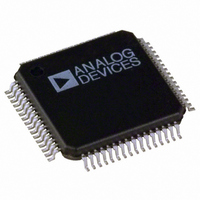ADV7180BSTZ Analog Devices Inc, ADV7180BSTZ Datasheet - Page 39

ADV7180BSTZ
Manufacturer Part Number
ADV7180BSTZ
Description
IC VIDEO DECODER SDTV 64-LQFP
Manufacturer
Analog Devices Inc
Type
Video Decoderr
Datasheet
1.ADV7180BSTZ.pdf
(116 pages)
Specifications of ADV7180BSTZ
Design Resources
Low Cost Differential Video Receiver Using ADA4851 Amplifier and ADV7180 Video Decoder (CN0060) Low Cost Video Multiplexer for Video Switching Using ADA4853-2 Op Amp with Disable Function (CN0076)
Applications
Digital Cameras, Mobile Phones, Portable Video
Voltage - Supply, Analog
1.71 V ~ 1.89 V
Voltage - Supply, Digital
1.65 V ~ 2 V
Mounting Type
Surface Mount
Package / Case
64-LQFP
Resolution (bits)
10bit
Input Format
Analog
Output Format
Digital
Adc Sample Rate
57.27MSPS
Power Dissipation Pd
15µW
No. Of Input Channels
6
Supply Voltage Range
1.71V To 1.89V
Lead Free Status / RoHS Status
Lead free / RoHS Compliant
For Use With
EVAL-ADV7180LQEBZ - BOARD EVALUATION ADV7180EVAL-ADV7180LFEBZ - BOARD EVAL FOR ADV7180 LFCSP
Lead Free Status / RoHS Status
Lead free / RoHS Compliant, Lead free / RoHS Compliant
Available stocks
Company
Part Number
Manufacturer
Quantity
Price
Company:
Part Number:
ADV7180BSTZ
Manufacturer:
AMIS
Quantity:
6 240
Company:
Part Number:
ADV7180BSTZ
Manufacturer:
Analog Devices Inc
Quantity:
10 000
Part Number:
ADV7180BSTZ
Manufacturer:
ADI/亚德诺
Quantity:
20 000
Company:
Part Number:
ADV7180BSTZ-REEL
Manufacturer:
Analog Devices Inc
Quantity:
10 000
DIGITAL NOISE REDUCTION (DNR) AND LUMA
PEAKING FILTER
Digital noise reduction is based on the assumption that high
frequency signals with low amplitude are probably noise and
that their removal, therefore, improves picture quality. The
following are the two DNR blocks in the ADV7180: the DNR1
block before the luma peaking filter and the DNR2 block after
the luma peaking filter, as shown in Figure 30.
SIGNAL
DNR_EN, Digital Noise Reduction Enable, Address 0x4D[5]
The DNR_EN bit enables the DNR block or bypasses it.
Table 49. DNR_EN Function
Setting
0
1 (default)
DNR_TH[7:0], DNR Noise Threshold, Address 0x50[7:0]
The DNR1 block is positioned before the luma peaking block.
The DNR_TH[7:0] value is an unsigned, 8-bit number used to
determine the maximum edge that is interpreted as noise and,
therefore, blanked from the luma data. Programming a large
value into DNR_TH[7:0] causes the DNR block to interpret
even large transients as noise and remove them. As a result, the
effect on the video data is more visible. Programming a small
value causes only small transients to be seen as noise and to be
removed.
Table 50. DNR_TH[7:0] Function
Setting
0x08 (default)
LUMA
Figure 30. DNR and Peaking Block Diagram
Description
Bypasses DNR (disable)
Enables digital noise reduction on the luma data
DNR1
Description
Threshold for maximum luma edges to be
interpreted as noise
LUMA PEAKING
FILTER
DNR2
LUMA
OUTPUT
Rev. F | Page 39 of 116
PEAKING_GAIN[7:0], Luma Peaking Gain,
Address 0xFB[7:0]
This filter can be manually enabled. The user can select to boost
or to attenuate the mid region of the Y spectrum around 3 MHz.
The peaking filter can visually improve the picture by showing
more definition on the picture details that contain frequency
components around 3 MHz. The default value on this register
passes through the luma data unaltered. A lower value attenuates
the signal, and a higher value gains the luma signal. A plot of
the filter’s responses is shown in Figure 31.
Table 51. PEAKING_GAIN[7:0] Function
Setting
0x40 (Default)
DNR_TH2[7:0], DNR Noise Threshold 2,
Address 0xFC[7:0]
The DNR2 block is positioned after the luma peaking block
and, therefore, affects the gained luma signal. It operates in the
same way as the DNR1 block, but there is an independent
threshold control, DNR_TH2[7:0], for this block. This value is
an unsigned, 8-bit number used to determine the maximum
edge that is interpreted as noise and, therefore, blanked from
the luma data. Programming a large value into DNR_TH2[7:0]
causes the DNR block to interpret even large transients as noise
and remove them. As a result, the effect on the video data is more
visible. Programming a small value causes only small transients
to be seen as noise and to be removed.
Table 52. DNR_TH2[7:0] Function
Setting
0x04 (default)
–10
–15
–20
15
10
–5
5
0
0
1
Figure 31. Peaking Filter Responses
Description
0 dB response
Description
Threshold for maximum luma edges to be
interpreted as noise
PEAKING GAIN USING BP FILTER
2
FREQUENCY (MHz)
3
4
5
ADV7180
6
7













